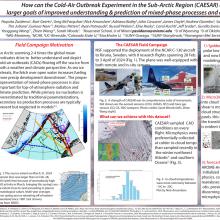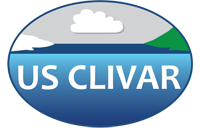Microphysical Impacts on Arctic Mixed-Phase Cold-Air Outbreak Cloud Morphology based on Cloud Age: Towards developing an appropriate framework in which to place multiple observations and simulations
Paquita
Zuidema
University of Miami/Rosenstiel School
Poster
Cold-air outbreaks (CAOs) in the sub-Arctic represent one process by which high- and mid-latitudes, and the polar stratosphere and troposphere, exchange air masses with each other. Predictions of future climate do not agree on whether such CAOs will either increase or decrease in frequency, with implications for Arctic weather. Microphysical representations in models of mixed-phase CAOs highlight how glaciation and riming can facilitate transitions to lower-albedo clouds, but observations also stress the importance of liquid water production to maintaining higher-albedo clouds.
We hypothesize a dependence on cloud age related to the surface flux strength for Arctic CAOs: younger CAOs, with strong surface fluxes maintain a consistent liquid-dominated albedo in which clouds organize into streets. In contrast, for older CAOs for which the near-surface air is more equilibrated to the ocean surface temperature, glaciation processes facilitate a transition to more open-celled structures with lower cloud albedos. Glaciation processes (riming versus vapor deposition) may also depend on CAO age. In this presentation we explore how new observations from a recent NSF field campaign (CAESAR) can be related to this framework, in which other influences (e.g. subsidence, aerosol) are considered secondary. We will examine the relationship of microphysics to the macrophysical characteristics for select cases. A goal is to use this workshop to develop a framework in which further observations and model experimentation can be placed.
A poster presentation is preferred. The most applicable session is ‘how are observations being used to improve models’ and a relevant topic is: ‘current status and needs: Field data synthesis’.
We hypothesize a dependence on cloud age related to the surface flux strength for Arctic CAOs: younger CAOs, with strong surface fluxes maintain a consistent liquid-dominated albedo in which clouds organize into streets. In contrast, for older CAOs for which the near-surface air is more equilibrated to the ocean surface temperature, glaciation processes facilitate a transition to more open-celled structures with lower cloud albedos. Glaciation processes (riming versus vapor deposition) may also depend on CAO age. In this presentation we explore how new observations from a recent NSF field campaign (CAESAR) can be related to this framework, in which other influences (e.g. subsidence, aerosol) are considered secondary. We will examine the relationship of microphysics to the macrophysical characteristics for select cases. A goal is to use this workshop to develop a framework in which further observations and model experimentation can be placed.
A poster presentation is preferred. The most applicable session is ‘how are observations being used to improve models’ and a relevant topic is: ‘current status and needs: Field data synthesis’.

zuidema-paquita-poster.pdf
(1012.2 KB)
Meeting homepage
